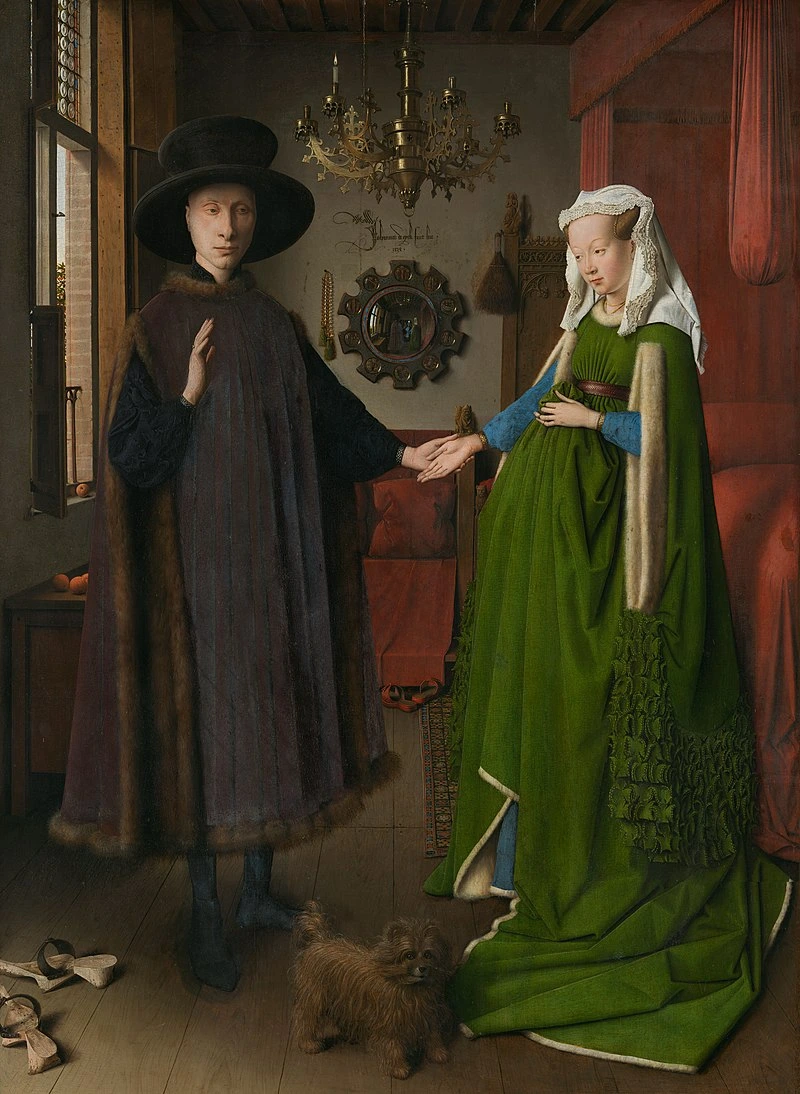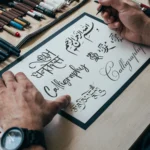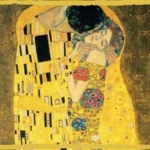
Welcome to our exploration of one of the most iconic masterpieces in art history: Jan van Eyck’s “The Arnolfini Portrait.” This captivating painting, created in 1434, is renowned not only for its stunning realism and intricate details but also for the rich symbolism and mystery that surrounds its subjects. As we delve into the fascinating world of this early Netherlandish artwork, we will uncover 25 interesting facts that highlight its artistic significance, cultural impact, and enduring legacy. Whether you’re an art enthusiast, a history buff, or simply curious about the stories behind great works of art, join us on this journey to discover what makes “The Arnolfini Portrait” a timeless treasure of the art world.
Artist: Jan van Eyck, a prominent figure of the Northern Renaissance, is credited with the creation of “The Arnolfini Portrait” in 1434. He is often hailed as one of the pioneers of oil painting, which allowed for greater detail and realism than the tempera paints commonly used before his time. Van Eyck’s mastery of oil paints enabled him to achieve a luminosity and depth that became hallmarks of his work, influencing generations of artists. His attention to detail and innovative techniques set a new standard for realism in portraiture.
Medium: The painting is executed in oil on an oak panel, a medium that was relatively new and gaining popularity during the early 15th century in Europe. The use of oil paint allowed for greater flexibility in blending colors and achieving intricate details. Van Eyck’s application of thin glazes created a rich texture and depth, contributing to the lifelike quality of the figures and objects depicted. The oak panel provides a sturdy surface that has helped the painting endure through the centuries, maintaining its vibrancy and clarity.
Dimensions: Measuring approximately 82.2 cm × 60 cm (32.3 in × 23.6 in), “The Arnolfini Portrait” is a relatively small painting, which adds to its intimate nature. The size allows it to be displayed in domestic settings, making it accessible to viewers in a personal context. Despite its modest dimensions, the painting is packed with detail and symbolism, encouraging viewers to engage closely with its elements. The scale also reflects the trend of creating smaller, more personal works of art during the Northern Renaissance.
Location: “The Arnolfini Portrait” is housed in the National Gallery in London, where it is part of a significant collection of European paintings. The National Gallery, established in 1824, is home to numerous masterpieces from various periods, and Van Eyck’s work is one of its highlights. The painting attracts thousands of visitors each year, who come to admire its intricate details and rich symbolism. Its presence in such a prestigious institution underscores its importance in art history and its influence on subsequent generations of artists.
Subjects: The figures in the portrait are believed to be Giovanni di Nicolao di Arnolfini, a wealthy Italian merchant, and his wife, Costanza Trenta. The couple is depicted standing in a domestic interior, which may represent their home in Bruges, where they lived. The identities of the subjects have been the subject of much debate among art historians, with some suggesting alternative interpretations. Regardless of their exact identities, the portrait serves as a testament to the social status and wealth of the Arnolfini family during the 15th century.
Marriage Symbolism: “The Arnolfini Portrait” is often interpreted as a marriage portrait, although its exact purpose remains a topic of scholarly debate. The positioning of the couple, the presence of the dog, and various objects in the painting suggest themes of fidelity, love, and domesticity. The act of holding hands may symbolize their union, while the presence of the witness figures in the mirror hints at a ceremonial aspect. Some interpretations also suggest that the painting may serve as a legal document, affirming the marriage and the couple’s social standing.
Mirror: A striking feature of the painting is the convex mirror located in the background, which reflects the couple and two additional figures, likely witnesses to the marriage. This mirror not only adds depth to the composition but also serves to invite viewers into the scene, creating a sense of participation in the moment. The mirror reflects the intricate details of the room and the figures, showcasing Van Eyck’s skill in rendering reflections and light. It also emphasizes the importance of the marriage ceremony, as it suggests that the event is being observed by others.
Detailing: Jan van Eyck is renowned for his meticulous attention to detail, which is evident throughout “The Arnolfini Portrait.” From the intricate textures of the fabrics to the fine details of the objects in the room, every element is rendered with precision. The painter’s ability to depict light and shadow enhances the realism of the scene, making the figures appear almost lifelike. This level of detail was groundbreaking for its time and set a new standard for realism in art, influencing many artists who followed in the Northern Renaissance.
Signature: Van Eyck’s signature is prominently displayed on the wall above the mirror, reading “Johannes de Eyck fuit hic 1434,” which translates to “Jan van Eyck was here 1434.” This signature serves not only as a mark of authorship but also as a statement of the artist’s presence in the creation of the work. It highlights the importance of the artist in the narrative of the painting and serves as a reminder of the personal engagement Van Eyck had with his subjects and the scene he depicted. The inclusion of the date adds historical context, anchoring the painting in a specific time and place, and underscores the significance of the moment captured in the artwork. This self-referential aspect of the signature invites viewers to consider the relationship between the artist, the subjects, and the act of creation itself.
Perspective: The use of linear perspective in “The Arnolfini Portrait” was innovative for its time, contributing to the painting’s depth and spatial organization. Van Eyck skillfully arranged the composition to create a believable three-dimensional space, drawing the viewer’s eye into the interior setting. The placement of objects, such as the bed and the chandelier, helps to establish a sense of foreground and background, enhancing the realism of the scene. This technique was part of a broader movement in Renaissance art, where artists began to explore and implement perspective to create more lifelike representations of space and form, ultimately influencing the development of Western art.
Light: Jan van Eyck’s masterful use of light is a defining characteristic of “The Arnolfini Portrait.” He employed light to create a sense of volume and realism, illuminating the figures and objects in the scene in a way that enhances their three-dimensionality. The way light interacts with different surfaces, such as the shiny texture of the brass candelabrum and the soft fabric of the garments, showcases his ability to depict various materials accurately. This manipulation of light not only adds to the overall realism but also contributes to the mood of the painting, creating a serene and intimate atmosphere that invites viewers to engage with the scene.
Fashion: The clothing worn by Giovanni and Costanza reflects the fashion of the early 15th century, showcasing the wealth and status of the couple. Giovanni is depicted in a dark, luxurious robe with a fur collar, while Costanza wears a richly adorned gown with intricate details and a flowing headdress. These garments are indicative of the high social standing of the Arnolfini family and highlight the attention to detail that Van Eyck employed in rendering fabrics and textures. The fashion depicted in the painting not only serves as a historical reference but also enhances the narrative of the couple’s prosperity and social significance.
Color Palette: The color palette of “The Arnolfini Portrait” is rich and varied, primarily featuring deep greens, reds, and golds. Van Eyck’s use of color is deliberate, with each hue chosen to evoke certain emotions and to enhance the overall composition. The vibrant greens of the drapery contrast beautifully with the warm tones of the wooden floor and the cooler colors of the background. This careful selection of colors contributes to the painting’s depth and richness, drawing the viewer’s eye to various focal points within the artwork. The harmonious color scheme also reflects the artist’s skill in creating a balanced and visually appealing composition.
Flooring: The distinctive checkerboard floor in “The Arnolfini Portrait” is a significant element that adds to the painting’s depth and perspective. The alternating light and dark tiles create a sense of movement and lead the viewer’s eye into the scene, enhancing the illusion of space. This geometric pattern contrasts with the organic forms of the figures and the furnishings, creating a dynamic visual interplay. Additionally, the floor serves as a grounding element in the composition, establishing a solid base for the figures and reinforcing the domestic setting of the portrait.
Historical Context: “The Arnolfini Portrait” is considered a significant work of the Northern Renaissance, a period characterized by a renewed interest in realism, detail, and the use of oil paints. Created in 1434, the painting reflects the cultural and economic prosperity of the Burgundian Netherlands during this time. The Northern Renaissance was marked by advancements in artistic techniques and a focus on individualism, which is evident in the intimate portrayal of the Arnolfini couple. The painting not only exemplifies the artistic achievements of the era but also serves as a historical document that captures the social customs and values of 15th-century Europe.
Symbolic Objects: Throughout “The Arnolfini Portrait,” various objects carry symbolic meanings that contribute to the overall narrative of the painting. The brass candelabrum, with its single lit candle, symbolizes the presence of God and the sanctity of marriage. The dog at the couple’s feet represents fidelity and loyalty, while the fruit on the windowsill may signify fertility and abundance. Each object is carefully placed to enhance the themes of love, commitment, and domestic life, inviting viewers to explore the deeper meanings behind the seemingly simple scene.
Restoration: “The Arnolfini Portrait” has undergone several restorations over the years to preserve its original colors and details. These restoration efforts have been crucial in maintaining the painting’s vibrancy and clarity, ensuring that viewers can appreciate Van Eyck’s masterful techniques. Modern conservation practices have allowed art historians and conservators to study the painting more closely, revealing insights into Van Eyck’s methods and materials. The ongoing preservation of this masterpiece highlights the importance of maintaining cultural heritage and the challenges faced in protecting artworks from the effects of time and environmental factors.
Cultural Impact: The cultural impact of “The Arnolfini Portrait” is profound, as it has been analyzed and referenced in various art historical texts, literature, and popular culture. The painting’s intricate details and rich symbolism have sparked numerous interpretations and discussions among scholars and art enthusiasts alike. It has influenced artists across generations, inspiring works that explore similar themes of marriage, fidelity, and domestic life. The portrait’s enduring legacy is a testament to its significance in the canon of Western art and its ability to resonate with audiences throughout the centuries.
Artistic Influence: Jan van Eyck’s pioneering techniques in oil painting significantly influenced the trajectory of Western art. His mastery of layering and glazing allowed for unprecedented depth and richness of color, setting a new standard for realism in painting. As one of the first artists to utilize oil paint extensively, Van Eyck’s methods inspired a generation of artists in the Northern Renaissance and beyond. Notable figures such as Rogier van der Weyden and Hans Memling drew from his innovations, which paved the way for the development of oil painting techniques that would dominate the art world for centuries.
Restoration: “The Arnolfini Portrait” has undergone several restoration efforts to maintain its vibrancy and detail, essential for preserving the artwork’s integrity. Over the years, various conservation techniques have been applied to address issues such as discoloration and varnish degradation. These restorations aim to reveal Van Eyck’s original colors and intricate details, which may have been obscured by time and environmental factors. Such efforts are crucial for ensuring that future generations can appreciate the painting’s historical and artistic significance in its truest form.
Cultural Impact: The cultural impact of “The Arnolfini Portrait” extends beyond the realm of art history; it has been referenced in numerous texts, exhibitions, and popular culture. Scholars and critics have analyzed its complex themes, symbolism, and the mysterious identity of the figures depicted. Its presence in literature and media showcases its enduring relevance and the fascination it inspires. The painting has become a touchstone for discussions about marriage, identity, and the role of women in society, illustrating how art can reflect and influence cultural narratives across time.
Interpretations: The relationship between the figures in “The Arnolfini Portrait” has sparked diverse interpretations among art historians and viewers alike. Some suggest it is a wedding portrait, symbolizing the union of Giovanni di Nicolao di Arnolfini and his wife, while others propose it may represent a betrothal or a commemorative image. The ambiguity of their gestures, particularly the raised hand of the man, invites speculation on their intentions and the nature of their relationship. This multifaceted interpretation contributes to the painting’s allure and encourages ongoing dialogue about its meaning and significance.
Art Movement: “The Arnolfini Portrait” is a hallmark of early Netherlandish painting, characterized by its meticulous attention to detail and realistic representation of subjects. This movement emerged in the 15th century, emphasizing naturalism and the use of oil paints to achieve lifelike textures and colors. Van Eyck’s work exemplifies the artistic innovations of the time, showcasing intricate fabrics, reflective surfaces, and a nuanced understanding of light and shadow. The painting’s significance lies not only in its aesthetic qualities but also in its role in advancing the techniques and themes that would define Northern Renaissance art.
Perspective Techniques: Jan van Eyck’s use of atmospheric perspective in “The Arnolfini Portrait” enhances the painting’s spatial depth and realism. By employing subtle gradations of color and clarity to depict the background, he creates a sense of distance that draws the viewer’s eye into the scene. This technique, combined with his detailed rendering of textures and forms, contributes to the overall composition’s three-dimensional quality. Van Eyck’s innovative approach to perspective was groundbreaking for its time and has influenced countless artists in their quest to achieve realism in their works.
Legacy: “The Arnolfini Portrait” is widely regarded as one of the most significant works in Western art history, leaving an indelible mark on the art world. Its rich symbolism, technical mastery, and enigmatic subject matter continue to captivate audiences and scholars alike. The painting has inspired countless interpretations and has been a focal point in discussions about the evolution of art techniques and themes. Its legacy endures in the way it challenges viewers to engage with its complexities, making it a timeless piece that remains relevant in contemporary art discourse.
FAQs about The Arnolfini Portrait
1. What is The Arnolfini Portrait?
The Arnolfini Portrait is a renowned oil painting by the Early Netherlandish painter Jan van Eyck, created in 1434. It is housed at the National Gallery in London. The painting depicts a couple, believed to be Giovanni Arnolfini and his wife, in a richly detailed interior setting.
2. Who are the people in the painting?
While the painting is often referred to as “The Arnolfini Portrait,” the identities of the couple have been debated for centuries. The most widely accepted theory is that the painting depicts Giovanni di Nicolao Arnolfini and his wife, Costanza Trenta. However, some scholars have proposed alternative interpretations.
3. What is the significance of the inscription on the wall?
The inscription on the wall reads, “Johannes de Eyck fuit hic 1434.” This translates to “Jan van Eyck was here 1434.” This inscription has led to various interpretations, including the idea that it serves as a witness to a marriage ceremony or a symbolic act of artistic creation.
4. What are the symbolic elements in the painting?
The painting is rich in symbolism, which adds layers of meaning to the work. Some of the key symbols include:
- The chandelier with a single lit candle: This symbolizes the divine presence.
- The convex mirror: The mirror reflects figures in the room, including possibly the artist himself. It also contains small paintings depicting scenes from the Passion of Christ.
- The dog: Dogs were often associated with fidelity and loyalty in medieval and Renaissance art.
- The oranges: Oranges were a luxury item in 15th-century Europe and symbolized love, fertility, and purity.
- The woman’s green dress: Green was associated with fertility and rebirth.
5. What is the significance of the woman’s posture and clothing?
The woman’s posture, with her hands clasped and her head slightly bowed, suggests humility and piety. Her green dress, adorned with ermine fur, is a symbol of wealth and status. The way her dress is draped also emphasizes her pregnancy, which further alludes to fertility and new life.
6. What is the artistic technique used in the painting?
Jan van Eyck was a master of oil painting techniques. In The Arnolfini Portrait, he employs meticulous detail and realistic representation. The use of light and shadow, as well as the intricate rendering of textures, creates a sense of depth and realism. Van Eyck’s innovative use of oil paint allowed him to achieve a high degree of luminosity and transparency in his work.
7. Why is The Arnolfini Portrait considered such an important work of art?
The Arnolfini Portrait is considered a masterpiece of Early Netherlandish painting and a significant work of art history. Its intricate details, symbolism, and innovative techniques have fascinated art historians and viewers for centuries. The painting offers a glimpse into the lives of the wealthy and pious in 15th-century Europe, and it continues to inspire and intrigue.









